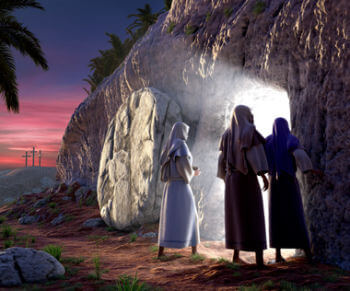 As I compose this, it’s the day of Christmas Eve. Because of the way the calendar falls this year, I’ll be going to Mass twice today – once for Sunday (the Fourth Sunday in Advent) and once for the Solemnity of the Nativity of Our Lord (Christmas). Delving into today’s readings to prepare for writing, I was surprised to find that the Gospel selection, from John, talks about Christ’s resurrection – in particular, Mary Magdalene reporting that Jesus’ body was missing from the tomb.
As I compose this, it’s the day of Christmas Eve. Because of the way the calendar falls this year, I’ll be going to Mass twice today – once for Sunday (the Fourth Sunday in Advent) and once for the Solemnity of the Nativity of Our Lord (Christmas). Delving into today’s readings to prepare for writing, I was surprised to find that the Gospel selection, from John, talks about Christ’s resurrection – in particular, Mary Magdalene reporting that Jesus’ body was missing from the tomb.
So, in the span of a day, I’ll be reflecting in some aspect on the entirety of Christ’s life, from the anticipation of his coming to his birth to the resurrection that’s a direct result of his crucifixion.
It’s worthwhile to note that today is the Feast Day of St. John the Apostle, commonly attributed as the “disciple whom Jesus loved” from today’s Gospel (also authored by John). And today’s first reading was from the First Letter of John. So there’s a lot of John in today’s readings, and it’s a great opportunity to reflect on the wisdom and journey of John.
John saw the transition from a life without Christ to knowing Jesus in his journey to seeing him die and – as promised – defeat death, leading to the hope of salvation to the world. That encapsulation also applies to reflecting on this Christmas season (writing it as I am while it’s still Advent).
Part of the human experience is understanding the greater shape of our own stories. As children, one of the first times we truly understand we’re alive is also understanding that we will, someday, die. Starting a marriage with our spouse involves making vows that last “’til death do you part” . . . a specter of gloom even on that happiest day. We usually baptize our babies shortly after they’re born – an acknowledgement that, even at the moment of birth, the threat of death remains a real possibility.
This doesn’t mean we’re dwelling in gloom or doom. Quite the opposite! It just means that we acknowledge reality . . . and reality includes understanding that there’s a progression of life that leads to death and (hopefully) life everlasting with God.
So, for me, today’s readings are a reminder of what all of this really means. Unlike what the secular world would push us toward, the celebration of the birth of Christ is not a standalone event unto itself, a time to exchange gifts and – at most – think of goodwill toward humanity. Although those are great aspects, the season is also a time to think about what Jesus’ life means in the larger sense.
That larger sense is well-represented by the entirety of the first reading, from the First Letter of John. Right now, I’ll focus on one bit that spoke to me: “for the life was made visible;
we have seen it and testify to it and proclaim to you the eternal life that was with the Father and was made visible to us . . . We are writing this so that our joy may be complete.”
Jesus’ birth brings the promise of “peace on Earth and goodwill toward men.” But it’s even more than that. Peace on Earth is just a part of what God’s plan for salvation entails.
In our own family, the birth of our son came with joy, relief, and anxiety about the future . . . all of it intermingled with a calm that stems from trusting God that He has a plan and – despite our uncertainty – it’ll all work out in the long run. The past, present, and future are playing out at once in today’s readings, and understanding that it’s all part of the same glorious story can help us during the rest of the year when there aren’t beautiful lights, omnipresent carols, and delightful packages. The most wonderful gift God gave the world was the gift of Himself, and – with it – the promise of salvation and eternal life that came not from a full manger, but an empty tomb.
Today’s readings: 1 Jn 1:1-4; Ps 97:1-2,5-6,11-12; Jn 20:1A,2-8
